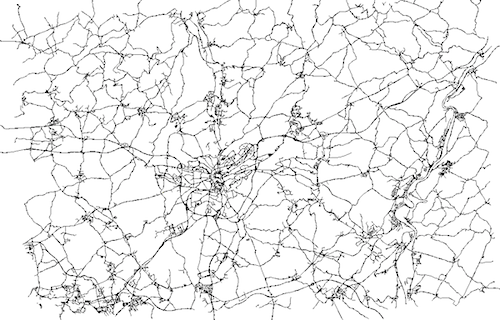Generation of realistic vehicular traces
Realistic vehicular traces are necessary in reliable VANETs simulations. Specific mobility of vehicles influences the connectivity of the network and thus has to be taken into account while testing protocols and applications designed for Intelligent Transportation Systems (ITSs) [1]. The lack of sufficiently detailed and large scale real-world traces compelled researchers to work on generation of artificial vehicular traces.
Modelling of vehicular traffic is complex and requires a multilevel approach. At a microscopic level, the movement of every single vehicle is defined by a mobility model. Advanced mobility models considers physical dynamics of a vehicle as well as the interaction with the surrounding environment (other vehicles and road infrastructure) [2]. At macroscopic level, traffic demand is defined in terms of origins and destinations (OD) of traffic flows. Additionally, vehicular mobility is time-variant and presents different characteristics (e.g. density, speed) dependent on a considered scenario. Vehicular traces are usually represented as a set of individual trips that are described by:
- time and place of the origin,
- sequence of road segments leading to the destination,
- vehicle type.
Traces are used in VANETs simulations to define exact positions of nodes in an underlying ad hoc network. We provide customised sets of realistic traces presenting commuting traffic over the area of Luxembourg. Traces were generated by the VehiLux model and augmented with Gawron's dynamic route assignment algorithm [3]. Users can download traces of the maximum coverage area 51km x 44km and time-span 11 hours.
 Fig 1. Luxembourg area.
Fig 1. Luxembourg area.
Vehicular ad hoc network (VANET) is a special type of mobile ad hoc networks (MANETs) consisting of moving vehicles. VANETs use vehicle-to-vehicle (V2V) as well as vehicle-to-infrastructure (V2I) communication, for providing drivers with novel services, such as collision avoidance, realtime traffic information, high-speed toll collection and infotainment. The emergence of these networks has raised novel research challenges that are different from regular MANETs. These challenges are induced by the high speed of the vehicles, which leads to specific mobility and connectivity patterns [4].
Simulation of VANETs is a complementary to costly and often limited in scale testbed experiments. Simulations are the most often used methods for evaluation of performance and impact of VANETs solutions. Simulations of VANETs are challenging and require to implement many aspects, e.g. a networking protocol stack, physical channel characteristics as well as mobility of vehicles at microscopic and macroscopic level [5].
Traces are used as an input to a network simulator, such as NS-3 to test the performance of the network for new communication standards and data dissemination protocols. For this purpose, the large set of artificial traces is usually generated by traffic microsimulator, e.g. SUMO that specifies positions of every node for each simulation step as presented in Fig. 2.
 Fig 2. Offline VANETs simulation.
Fig 2. Offline VANETs simulation.
VANET-based traffic information systems (TISs) aim in improving traffic efficiency by providing drivers with real-time road information and suggesting actions to be taken upon traffic related problems [6]. In order to evaluate impact of such systems on the road performance by the simulation the bi-directionally coupling between simulators is needed. Fig. 3 shows the general approach of VANETs simulation, where the information obtained by application requires an online update of vehicle positions in traffic simulator.
 Fig 3. Online VANETs simulation
Fig 3. Online VANETs simulation
- References:
- Fiore, M.; Harri, J.; Filali, F.; Bonnet, C.; , "Understanding Vehicular Mobility in Network Simulation," Mobile Adhoc and Sensor Systems, 2007. MASS 2007. IEEE Internatonal Conference on , vol., no., pp.1-6, 8-11 Oct. 2007
- Harri, J.; Filali, F.; Bonnet, C.; , "Mobility models for vehicular ad hoc networks: a survey and taxonomy," Communications Surveys & Tutorials, IEEE , vol.11, no.4, pp.19-41, Fourth Quarter 2009
- C. Gawron. An iterative algorithm to determine the dynamic user equilibrium in a traffic simulation model. International Journal of Modern Physics C, 9(3):393–407, 1998
- Schoch, E.; Kargl, F.; Weber, M.; Leinmuller, T.; , "Communication patterns in VANETs," Communications Magazine, IEEE , vol.46, no.11, pp.119-125, November 2008
- Grzybek, Agata; Seredynski, Marcin; Danoy, Gregoire; Bouvry, Pascal; , "Aspects and trends in realistic VANET simulations," World of Wireless, Mobile and Multimedia Networks (WoWMoM), 2012 IEEE International Symposium on a , vol., no., pp.1-6, 25-28 June 2012 [doi]
- Seredynski, M.; Bouvry, P.; , "A survey of vehicular-based cooperative traffic information systems," Intelligent Transportation Systems (ITSC), 2011 14th International IEEE Conference on , vol., no., pp.163-168, 5-7 Oct. 2011 [doi]


